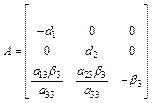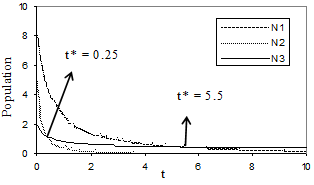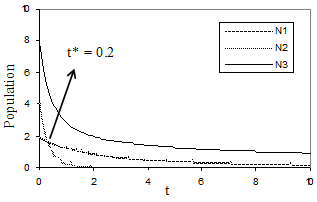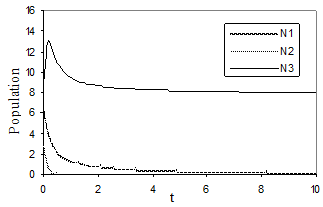A Study on Syn Ecology Consisting of Two Hosts and One Commensal with Mortality Rate for the First and Second Species
B. Hari Prasad*
Department of Mathematics, Chaitanya Degree College (Autonomous), Hanamkonda, Telangana State, India
Abstract
The present investigation is a study on syn ecology with mortality rate for the first and second species. The system comprises of two hosts S1, S2 and one commensal S3 i.e. S1 and S2 both benefit S3, without getting themselves affected either positively or adversely. Further S1 and S2 are neutral. The model equations constitute a set of three first order non-linear differential equations. Criteria for the asymptotic stability of all the eight equilibrium states are established. Trajectories of the perturbations over the equilibrium states are illustrated. Further, the global stability of the system is established with the aid of suitably constructed Liapunov’s function and the numerical examples for the growth rate equations are computed using Runge-Kutta fourth order method.
Keywords
Commensal, Host, Liapunov’s Function, Stable, Trajectories, Unstable
Received: April 4, 2015 / Accepted: April 25, 2015 / Published online: May 19, 2015
@ 2015 The Authors. Published by American Institute of Science. This Open Access article is under the CC BY-NC license. http://creativecommons.org/licenses/by-nc/4.0/
1. Introduction
Ecology, a branch evolutionary biology, deals with living species that coexist in a physical environment & sustain themselves on common resources. It is a common observation that the species of same nature can not flourish is isolation without any interaction with species of different kinds. Significant researches in the area of theoretical ecology have been discussed by Kot [1] and by [2]. Several ecologists and mathematicians contributed to the growth of this area of knowledge. Mathematical ecology can be broadly divided into two main sub-divisions, Autecology and Synecology, which are described in the treatises of Arumugam [3], Sharma [4]. Syn-ecology is an ecosystem comprised of two or more distinct species. Species interact with each other in one way or other. The Ecological interactions can be classified as Ammensalism, Competition, Commensalism, Neutralism, Mutualism, Predation, Parasitism and so on. Mathematical Modeling plays a vital role in providing insight into the mutual relationships (positive, negative) between the interacting species. The general concepts of Modeling in Biological Science have been initiated by several authors Ma [5], Murray [6], and Sze-Bi Hsu [7]. Recently the authors Papa Rao et al. [8], Shivareddy et al. [9], Srinivas [10] and Kumar et al. [11] discussed three species ecological models such as predation, completion and commensalism. Srinivas [12] studied the competitive ecosystem of two species and three species with limited and unlimited resources. Later, Narayan et al. [13] studied prey-predator ecological models with partial cover for the prey and alternate food for the predator. Acharyulu et al. [14,15] derived some productive results on various mathematical models of ecological Ammensalism with multifarious resources in the manifold directions. Further, Kumar [16] studied some mathematical models of ecological commensalism. The present author Prasad [17-20] investigated continuous and discrete models on the three species syn-ecosystems.
In this paper we study on the three species syn-eco system with mortality rate for the first and second species. The system comprises of two hosts S1, S2 and one commensal S3 i.e. S1 and S2 both benefit S3, without getting themselves affected either positively or adversely. Further, S1 and S2 are neutral. Commensalism is a symbiotic interaction between two populations where one population (S1) gets benefit from (S2) while the other (S2) is neither harmed nor benefited due to the interaction with (S1). The benefited species (S1) is called the commensal and the other (S2) is called the host. Some real-life examples of commensalism are presented below.
(i). A squirrel in an oak - tree gets a place to live and food for its survival, while the tree remains neither benefited nor harmed.
(ii). A flatworm attached to the horse crab and eating the crab’s food, while the crab is not put to any disadvantage.
Notation Adopted
![]() : The population strength of
: The population strength of ![]() at time
at time ![]() ,
, ![]()
![]() : Time instant
: Time instant ![]() : Natural death rates of
: Natural death rates of ![]() and
and ![]()
![]() : Natural growth rate of
: Natural growth rate of ![]()
![]() : Self inhibition coefficients of
: Self inhibition coefficients of ![]() ,
, ![]()
![]() : Interaction coefficients of
: Interaction coefficients of ![]() due to
due to ![]() and
and ![]() due to
due to ![]()
![]() : Extinction coefficient of
: Extinction coefficient of ![]() ,
, ![]()
![]() : Carrying capacity of
: Carrying capacity of ![]() Further the variables
Further the variables ![]() are non-negative and the model parameters
are non-negative and the model parameters![]()
![]() are assumed to be non-negative constants.
are assumed to be non-negative constants.
2. Equilibrium States
The model equations for syn ecosystem are given by the following system of first order non-linear ordinary differential equations.
![]() (1)
(1)
![]() (2)
(2)
![]() (3)
(3)
The system under investigation has eight equilibrium states given by
![]()
![]() ,
,![]() ,
, ![]() ,
,![]() ,
,![]() ,
, ![]() ,
, ![]() ,
, ![]()
3. Stability of Equilibrium States
Let![]() where
where ![]() is a small perturbation over the equilibrium state
is a small perturbation over the equilibrium state ![]() .
.
The basic equations (1), (2) and (3) are quasi-linearized to obtain the equations for the perturbed state as,
![]() (4)
(4)
where

with ![]()
The characteristic equation for the system is
![]() (5)
(5)
The equilibrium state is stable, if all the roots of the equation (5) are negative in case they are real or have negative real parts, in case they are complex.
3.1. Stability of E1
In this case, we have

The characteristic equation is
![]() (6)
(6)
The characteristic roots of (6) are ![]() . Since one of these three roots is positive. Hence the state is unstable and the solutions of the equations (4) are
. Since one of these three roots is positive. Hence the state is unstable and the solutions of the equations (4) are
![]()
where ![]() are the initial values of
are the initial values of ![]() respectively.
respectively.
The trajectories in ![]() and
and ![]() planes are given by
planes are given by

3.2. Stability of E2
In this case, we have

The characteristic roots are ![]() . Since one of these three roots is positive, hence the state is unstable and the solutions are
. Since one of these three roots is positive, hence the state is unstable and the solutions are
![]()
where ![]()
The trajectories in the ![]() ;
;![]() planes are given by
planes are given by

3.3. Stability of E3
In this case, we have

The characteristic roots are ![]() . Since one of these three roots is positive, hence the state is unstable. The equations (4) yield the solutions,
. Since one of these three roots is positive, hence the state is unstable. The equations (4) yield the solutions,
![]()
where ![]()
The trajectories in the ![]() ;
;![]() planes are
planes are

3.4. Stability of E4
In this case, we get

The characteristic roots are ![]() . Since all the three roots are negative, hence the state is stable. The equations (4) yield the solutions,
. Since all the three roots are negative, hence the state is stable. The equations (4) yield the solutions,
![]()
![]()
where ![]() and
and ![]() with
with ![]()
The trajectories in the ![]() ;
; ![]() planes are given by
planes are given by ![]() and
and 
3.5. Stability of E5
In this case, we get

The characteristic roots are ![]() . Since two of these three roots are positive, hence the state is unstable. The equations (4) yield the solutions,
. Since two of these three roots are positive, hence the state is unstable. The equations (4) yield the solutions,
![]()
The trajectories in the ![]() ;
;![]() planes are given by
planes are given by

3.6. Stability of E6
In this case,

The characteristic roots are ![]() . Since one of these three roots is positive, hence the state is unstable. The equations (4) yield the solutions,
. Since one of these three roots is positive, hence the state is unstable. The equations (4) yield the solutions,
![]()
![]()
where ![]() ;
; ![]()
with ![]()
The trajectories in the ![]() ;
; ![]() planes are given by
planes are given by ![]() and
and

3.7. Stability of E7
In this case, we get 
The characteristic roots are ![]() . Since one of these three roots is positive, hence the state is unstable. The equations (4) yield the solutions,
. Since one of these three roots is positive, hence the state is unstable. The equations (4) yield the solutions,
![]()
![]()
where ![]() ;
; ![]()
with ![]()
The trajectories in the ![]() ;
; ![]() planes are given by
planes are given by![]() and
and

3.8. Stability of E8
In this case, we get

The characteristic roots are![]() . Since two of these three roots are positive, hence the state is unstable. The equations (4) yield the solutions,
. Since two of these three roots are positive, hence the state is unstable. The equations (4) yield the solutions,
![]()
![]()
where ![]()
![]()
with ![]() and
and ![]()
The trajectories in the ![]() ;
; ![]() planes are given by
planes are given by ![]() and
and

4. Liapunov’s Function
In section 5 we discussed the local stability of all eight equilibrium states, from which only one state ![]() is stable and rest of them are unstable. We now examine the global stability of dynamical system (1), (2) and (3) at this state by suitable Liapunov’s function.
is stable and rest of them are unstable. We now examine the global stability of dynamical system (1), (2) and (3) at this state by suitable Liapunov’s function.
Theorem. The equilibrium state ![]() is globally asymptotically stable.
is globally asymptotically stable.
Proof. Let us consider the following Liapunov’s function
![]()
Now, the time derivative of L, along with solution (3) can be written as
![]()
![]()
![]()
![]()
which is negative definite.
Hence, the steady state is globally asymptotically stable.
5. Numerical Examples
The numerical solutions of the growth rate equations (1), (2) and (3) computed employing the fourth order Runge-Kutta method for specific values of the various parameters that characterize the model and the initial conditions. The results are illustrated in Figures 1, 2 and 3.

Figure 1. Variation of N1, N2, N3 against time (t) for d1 = 0.14, a11 = 0.24, a13 = 1.04, d2 = 0.66, a22 = 1.56, a23 = 0.42, a3 = 2.92, a33 = 7.68, N1 = 8, N2 = 5, N3 = 2.

Figure 2. Variation of N1, N2, N3 against time (t) for d1 = 0.10, a11 = 0.24, a13 = 5.74, d2 = 2.22, a22 = 0.34, a23 = 4.9, a3 = 2.82, a33 = 4.2, N1 = 2, N2 = 4, N3 = 8.

Figure 3. Variation of N1, N2, N3 against time (t) for d1 = 0.10, a11 = 0.60, a13 = 0.60, d2 = 8.1, a22 = 0.60, a23 = 2, a3 = 4.7, a33 = 0.60, N1 = 8, N2 = 2.5, N3 = 7.5.
6. Observations
Case 1: This is a situation at the self inhibition coefficient of the third species is highest. Initially the first and second species dominates over the third till the time instant t* = 5.5 and t* = 0.25 respectively and thereafter the dominance is reversed. Further, we notice that the initial values of S1, S2, S3 are in decreasing order. This is shown in Figure 1.
Case 2: In this case the initial values of S1, S2, S3 are in increasing order. Initially the second species dominates over the first till the time instant t* = 0.2 and thereafter the dominance is reversed. Further, it is evident that all the three species asymptotically converge to the equilibrium point as shown in Figure 2.
Case 3: This is a situation at the self inhibition coefficient of all the three species are identical. The third species dominates over the other two throughout. The natural death rate of S1 is greater than of S2. In course of time we notice a steady variation with no appreciable growth rate in all the three species. (Figure 3).
7. Conclusion
The present paper deals with an investigation on the stability of a three species syn ecology consisting of two hosts and one commensal with mortality rate for the first and second species. In this paper we established all possible equilibrium states. It is conclude that, in all eight equilibrium states, only one state E4 is stable. Further, the global stability is established with the help of suitable Liapunov’s function and the growth rates of the species are numerically estimated using Runge-Kutta fourth order method.
Acknowledgment
I thank to Professor (Retd), N.Ch.Pattabhi Ramacharyulu, Department of Mathematics, NIT, Warangal (T.S.), India for his valuable suggestions and encouragement.
References
- Kot, M. (2001), Elements of Mathematical Ecology, Cambridge University Press, UK.
- Gillman, M. (2009), An Introduction to Mathematical Models in Ecology and Evolution, Wiley-Blackwell, UK.
- Arumugam, N. (2006), Concepts of Ecology, Saras Publication, India.
- Sharma, P.D. (2009), Ecology and Environment, Rastogi Publications, India.
- Ma, Z. (1996), The Study of Biology Model, Anhui Education Press, China.
- Murray, J.D. (1993), Mathematical Biology, Springer, New York.
- Sze-Bi Hsu. (2004), Mathematical Modeling in Biological Science, Tsing-Hua University, Taiwan.
- Papa Rao, A.V.,Narayan, K.L. and Bathul, S. (2012), A Three Species Ecological Model with a Pray, Predator and a Competitor to both the Prey and Predator, International Journal of Mathematics and Scientific Computing, 2(1), 70 - 75.
- Shivareddy, K., Pattabhiramacharyulu, N.Ch. (2011), A Three Species Ecosystem Comprising of Two Predators Competing for a Prey, Advances in Applied Science Research, 2(3), 208 - 218.
- Srinivas, M.N. (2011), A Study of Bionomic Harvesting for a Three Species Ecosystem Consisting of Two Neutral Predators and a Prey, International Journal of Engineering Science and Technology, 3(10), 7491 - 7496.
- Kumar, N.P., Pattabhiramacharyulu, N.Ch. (2010), A Three Species Ecosystem Consisting of a Prey, Predator and a Host Commensal to the Prey, Int. J. Open Problems Compt. Math., 3(1), 92 - 113.
- Srinivas, N.C. (1991), Some Mathematical Aspects of Modeling in Bio-medical Sciences, Kakatiya University, Ph.D Thesis.
- Narayan, K.L., Pattabhiramacharyulu, N.Ch. (2007), A Prey-Predator Model with Cover for Prey and Alternate Food for the Predator and Time Delay, Int. Journal of Scientific Computing, 1, 7 - 14.
- Acharyulu, K.V.L.N., Pattabhiramacharyulu, N.Ch. (2010), An Enemy- Ammensal Species Pair With Limited Resources –A Numerical Study, Int. Journal Open Problems Compt. Math., 3,339-356.
- Acharyulu, K.V.L.N., Pattabhiramacharyulu, N.Ch. (2011), An Ammensal-Prey with three species Ecosystem, International Journal of Computational Cognition , 9, 30 - 39.
- Kumar, N.P. (2010), Some Mathematical Models of Ecological Commensalism, Acharya Nagarjuna University, Ph.D. Thesis.
- Prasad, B.H. (2014), On the Stability ofaThree Species Syn- Eco-System with Mortality RatefortheSecond Species. Int. Journal of Social Science & Interdisciplinary Research, 3, 35-45.
- Prasad,B.H. (2014), The Stability Analysis of a Three Species Syn – Eco – System with Mortality Rates. Contemporary Mathematics and Statistics, 2, 76-89.
- Prasad, B.H. (2014), A Study on DiscreteModelofThreeSpeciesSyn-Eco-System with Limited Resources. Int. JournalModern Education and Computer Science,11, 38-44.
- Prasad, B.H. (2014), A Discrete Model of a Typical Three Species Syn – Eco – System with Unlimited Resources for the First and Third Species. Asian Academic Research Journal o Multidisciplinary,1, 36-46.



